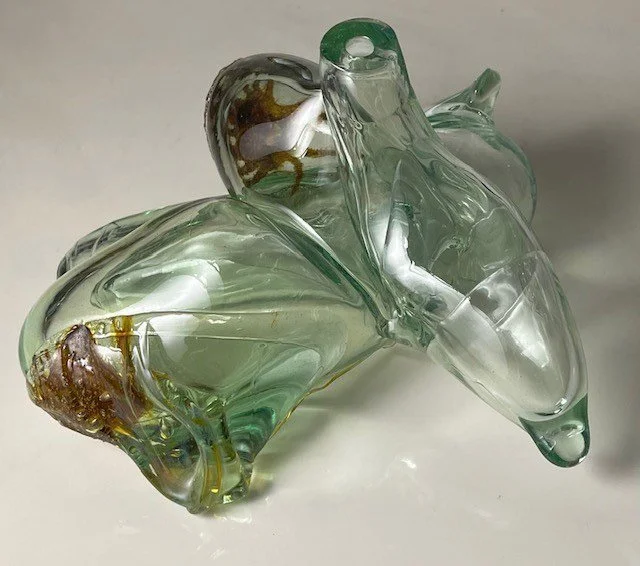Glass Spotlight
New to the Collection
Audrey Handler (American, born 1934)
Assisted by Fritz Dreisbach (American, born 1941)
Double-Blown Form, 1967
Clear 475 marble glass with silver nitrate
7 x 8 x 10 in. (17.8 x 20.3 x 25 cm)
Collection of Museum of Glass, gift of the artist
Museum of Glass is honored to be the recipient of several early career works by glass trailblazer Audrey Handler, one of the first female artists to study glassblowing in an academic setting, learning from Studio Glass founder Harvey Littleton. This untitled vessel was created while Handler was an MFA student of Littleton’s at University of Wisconsin. Handler remembered its creation as being a part of an important period of comradery and experimentation:
"Most of us worked alone, as Professor Littleton’s original idea was that an artist could do it all alone (distinct from a factory situation). But we knew some more complex ideas needed an assistant, and we liked to needle Harvey. After all, we were all learning together—the professor and the students—in those very early years."
This early work represents the seeds of collaboration and curiosity which helped Studio Glass grow into the international movement that we see at the Museum today.
On Loan
Beth Lipman (American, born 1971)
Oysters, Books, Fruit, and Candles, 2009
Glass, wood, paint, metal, and adhesive
39 1/2 x 54 x 43 in. (100.3 x 137.2 x 109.2 cm)
Collection of Museum of Glass, Tacoma, Washington, gift of the Robert M. Minkoff Foundation (2021.31.83)
We are pleased to share that Oysters, Books, Fruit, and Candles will be traveling to the Christian Peterson Art Museum at Iowa State University (ISU). It will be on loan for a survey of artist Beth Lipman’s career, in celebration of the unveiling of a site-specific installation for ISU.
Beth Lipman’s sculptural practice is rooted in the art history tradition of the still life. Pieces from her table series are inspired by 17th century paintings that used table settings, food, and other symbols to evoke themes of mortality, consumption, and materiality. By calling upon this historic tradition, Lipman’s glass sculptures serve as contemporary vanitas, with glass adding an additional layer of symbolism to the fragility of our human species.
In the Galleries
Paul J. Stankard (American, born 1943)
White Trillium Bouquet Orb with Honeybees, 2008
Blown glass with flameworked elements
3 3/4 in. (9.5 cm)
Collection of Museum of Glass, Tacoma, Washington, gift of the Robert M. Minkoff Foundation (2021.31.258)
Photo by Douglas Schaible Photography
Although smaller than a softball, White Trillium Bouquet Orb with Honeybees contains its own natural microcosm. It was created by master flameworker Paul Stankard, who has spent over four decades combining his considerable skill with a love of exploring the flora and fauna native to his backyard in the Northeastern United States. In this example, blueberry, forget-me-not, and Pineland pickerelweed flowers are sculpted exactingly from glass, surrounded by bees poised for pollination.
White Trillium Bouquet Orb with Honeybees is part of the exhibition Field Notes: Artists Observe Nature, which celebrates glass artists whose work is a balance of artistic celebration of natural phenomena and the detailed observational practice of natural historians.
Field Notes is open through December 2025.
From the Hot Shop
Kwun Lan Wong (Hong Konger, born 1996)
I Want to Talk to You, Made at the Museum in 2025
Blown and hot-sculpted glass
Collection of Museum of Glass, Tacoma, Washington, gift of the artist
I Want to Talk to You is an investigation of “in-between-ness” created by Visiting Artist Kwun Lan Wong during her April 2025 Hot Shop residency. While working with the Hot Shop Team, Wong created pieces inspired by Lo Ting, a mythological creature that is half-fish and half-human. Her work represents the struggles of the people of Hong Kong, who are searching for a place to call home as if stuck between land and sea.
Kwun Lan Wong received her MFA in Glass from Southern Illinois University, where she honed her hot-sculpting and glassblowing skills. Her art is often personal, and the work created during her residency examined the dichotomy of her cultural identity as a Hong Kong artist, and a feeling of in-between-ness as neither British nor Chinese. Her project proposal was selected from the largest pool of Museum of Glass residency applications in the last decade, and her residency week showcased the important role of glass in reflecting conversations about cultural belonging.




